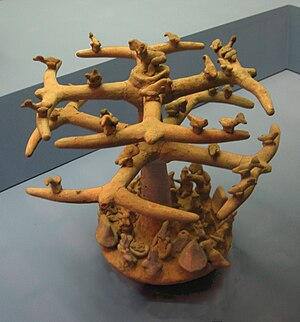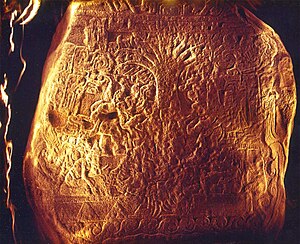20:
32:
171:
While the cosmic tree symbolism has deep roots in
Mesoamerican cultures, the precise botanical identification and underlying meaning of the motif remain poorly understood. Attempts have been made to identify the tree as a kapok, maize, or water lily, with the latter being a particularly prominent
172:
interpretation based on archaeological evidence from sites like San
Bartolo.The frequent personification of gods and rulers as manifestations of the world tree underscores its crucial symbolic and ritualistic significance in Mayan religion and kingship.
27:, showing a multi-layered tree with birds. It has been proposed that the birds represent souls who have not yet descended into the underworld, while the central tree may represent the Mesoamerican world tree.
148:. It is supposed that Mesoamerican sites and ceremonial centers frequently had actual trees planted at each of the four cardinal directions, representing the quadripartite concept.
161:
World trees are frequently depicted with birds in their branches, and their roots extending into earth or water (sometimes atop a "water-monster", symbolic of the underworld).
233:
78:
Depictions of world trees, both in their directional and central aspects, are found in the art and mythological traditions of cultures such as the
522:
411:
24:
498:
451:
400:
527:
319:
46:
241:
517:
478:
155:
142:
99:
470:
McDonald, J. Andrew. "Deciphering the
Symbols and Symbolic Meaning of the Maya World Tree". In:
126:
464:
266:
130:
75:
that connects the planes of the
Underworld and the sky with that of the terrestrial realm.
8:
164:
The central world tree has also been interpreted as a representation of the band of the
69:, which also serve to represent the fourfold nature of a central world tree, a symbolic
440:
66:
494:
447:
396:
369:
315:
79:
487:
361:
197:
187:
419:
349:
207:
192:
115:
365:
102:. Among the Maya, the central world tree was conceived as or represented by a
511:
373:
151:
134:
54:
36:
19:
435:
202:
154:
is considered a possible representation of a World Tree, as is the tree on
138:
125:
Directional world trees are also associated with the four
Yearbearers in
58:
50:
482:
433:
182:
71:
62:
312:
The Code of Kings: The
Language of Seven Sacred Maya Temples and Tombs
350:"Deciphering the Symbols and Symbolic Meaning of the Maya World Tree"
212:
165:
416:
The Real Maya
Prophecies: Astronomy in the Inscriptions and Codices
98:, and others, dating to at least the Mid/Late Formative periods of
118:. The trunk of the tree could also be represented by an upright
31:
119:
91:
474:
vol. 27, no. 2 (2016): 333–59. doi:10.1017/S0956536116000249.
145:
103:
95:
87:
83:
45:
are a prevalent motif occurring in the mythical cosmologies,
412:"Raising the sky: The Maya creation myth and the Milky Way"
477:
442:
Maya Cosmos: Three
Thousand Years on the Shaman's Path
255:
Heritage of Power: Ancient
Sculpture from West Mexico
314:. New York: Simon & Schuster. pp. 113–114.
489:
The Gods and
Symbols of Ancient Mexico and the Maya
486:
439:
133:which have this association outlined include the
509:
393:The Maya: Sacred Symbols (Sacred Symbols Series)
390:
253:, which further cites Butterwick, Kristi (2004)
465:Art 347L Mesoamerican Art Syllabus: West Mexico
409:
309:
122:, whose skin evokes the tree's spiny trunk.
129:, and the directional colors and deities.
347:
30:
18:
510:
310:Schele, Linda; Mathews, Peter (1998).
446:. New York: William Morrow & Co.
523:Mesoamerican mythology and religion
234:"Mexican and Central American Hall"
25:Western Mexico shaft tomb tradition
13:
238:American Museum of Natural History
14:
539:
106:tree and is known variously as a
418:. Maya Astronomy. Archived from
61:. In the Mesoamerican context,
391:Adkinson, Robert, ed. (1996).
341:
328:
303:
292:
280:
271:
260:
226:
1:
493:. London: Thames and Hudson.
395:. London: Thames and Hudson.
384:
257:, Metropolitan Museum of Art.
348:McDonald, J. Andrew (2016).
7:
175:
10:
544:
366:10.1017/s0956536116000249
158:sarcophagus at Palenque.
410:Finley, Michael (2003).
219:
467:", accessed April 2008.
156:Kʼinich Janaabʼ Pakal's
100:Mesoamerican chronology
127:Mesoamerican calendars
39:
28:
528:Religious cosmologies
438:; Joy Parker (1993).
34:
22:
131:Mesoamerican codices
472:Ancient Mesoamerica
434:Freidel, David A.;
354:Ancient Mesoamerica
114:, depending on the
67:cardinal directions
23:A tableau from the
518:Trees in mythology
286:Miller and Taube,
65:embodied the four
40:
29:
47:creation accounts
535:
504:
492:
462:
461:Kappelman, Julia
457:
445:
430:
428:
427:
406:
378:
377:
345:
339:
332:
326:
325:
307:
301:
296:
290:
284:
278:
275:
269:
264:
258:
252:
250:
249:
240:. Archived from
230:
543:
542:
538:
537:
536:
534:
533:
532:
508:
507:
501:
460:
454:
425:
423:
403:
387:
382:
381:
346:
342:
333:
329:
322:
308:
304:
297:
293:
285:
281:
276:
272:
265:
261:
247:
245:
232:
231:
227:
222:
217:
198:Olmec mythology
188:Aztec mythology
178:
143:Fejérváry-Mayer
17:
12:
11:
5:
541:
531:
530:
525:
520:
506:
505:
499:
475:
468:
458:
452:
431:
407:
401:
386:
383:
380:
379:
360:(2): 333–359.
340:
327:
320:
302:
291:
279:
270:
259:
224:
223:
221:
218:
216:
215:
210:
208:Vision Serpent
205:
200:
195:
193:Maya mythology
190:
185:
179:
177:
174:
116:Mayan language
35:Tree of Life,
15:
9:
6:
4:
3:
2:
540:
529:
526:
524:
521:
519:
516:
515:
513:
502:
500:0-500-05068-6
496:
491:
490:
484:
480:
476:
473:
469:
466:
459:
455:
453:0-688-10081-3
449:
444:
443:
437:
432:
422:on 2006-12-25
421:
417:
413:
408:
404:
402:0-500-06022-3
398:
394:
389:
388:
375:
371:
367:
363:
359:
355:
351:
344:
337:
331:
323:
317:
313:
306:
300:
295:
289:
283:
277:Finlay (2003)
274:
268:
263:
256:
244:on 2008-09-28
243:
239:
235:
229:
225:
214:
211:
209:
206:
204:
201:
199:
196:
194:
191:
189:
186:
184:
181:
180:
173:
169:
167:
162:
159:
157:
153:
152:Izapa Stela 5
149:
147:
144:
140:
136:
132:
128:
123:
121:
117:
113:
109:
105:
101:
97:
93:
89:
85:
81:
76:
74:
73:
68:
64:
60:
56:
55:pre-Columbian
52:
51:iconographies
48:
44:
38:
37:Izapa Stela 5
33:
26:
21:
488:
479:Miller, Mary
471:
441:
436:Linda Schele
424:. Retrieved
420:the original
415:
392:
357:
353:
343:
335:
330:
311:
305:
298:
294:
287:
282:
273:
262:
254:
246:. Retrieved
242:the original
237:
228:
203:Tree of life
170:
163:
160:
150:
124:
112:yax imix che
111:
107:
77:
70:
57:cultures of
42:
41:
63:world trees
59:Mesoamerica
43:World trees
512:Categories
483:Karl Taube
426:2007-01-04
385:References
321:0684852098
248:2008-04-23
183:Axis mundi
108:wacah chan
72:axis mundi
374:0956-5361
334:Freidel,
288:loc. cit.
267:Kappelman
213:Yggdrasil
166:Milky Way
485:(1993).
176:See also
146:codices
135:Dresden
53:of the
497:
450:
399:
372:
338:(1993)
336:et al.
318:
141:, and
139:Borgia
120:caiman
92:Mixtec
88:Izapan
49:, and
299:Ibid.
220:Notes
104:ceiba
96:Olmec
84:Aztec
16:Arepa
495:ISBN
448:ISBN
397:ISBN
370:ISSN
316:ISBN
80:Maya
362:doi
110:or
514::
481:;
414:.
368:.
358:27
356:.
352:.
236:.
168:.
137:,
94:,
90:,
86:,
82:,
503:.
463:"
456:.
429:.
405:.
376:.
364::
324:.
251:.
Text is available under the Creative Commons Attribution-ShareAlike License. Additional terms may apply.

